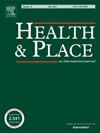Does nature make us less lonely? Analysis in Bulgaria's five largest cities
IF 4.1
2区 医学
Q1 PUBLIC, ENVIRONMENTAL & OCCUPATIONAL HEALTH
引用次数: 0
Abstract
Background
Loneliness is prevalent and increases risks of disease and premature death. We aimed to investigate whether greater exposure to nature is associated with less loneliness in urban Bulgarian adults, and whether the association was modified by sociodemographic factors.
Methods
The analytic sample comprised 3604 adults from a cross-sectional population-based survey conducted in 2023 in the five largest Bulgarian cities. Loneliness was self-reported with a single item on a seven-point Likert scale. Availability of nature was assessed by several GIS-derived indicators: normalised difference vegetation index (NDVI), tree cover density, urban green space, all in a 300 m buffer around home, and distance to blue space. Self-reported nature indicators included domestic garden, green space and blue space quality, green space and blue space window view, and time spent in green and blue space. Adjusted negative binomial regressions with random intercept for city district were used to assess associations with loneliness. We further checked effect modification by city type, sex, age, relationship, employment status and education.
Results
Residing in areas with more urban green space, higher green space quality, and green space window view and spending more time in green and blue space were associated with lower loneliness scores. Living in low or high compared to medium level NDVI settings or in areas with higher tree cover density was associated with higher loneliness scores. Sociodemographic factors modified some of these associations.
Conclusions
Our findings underscore the importance of extending and improving structured urban green spaces in Bulgarian cities.
大自然让我们不那么孤独了吗?保加利亚五大城市的分析
孤独是普遍存在的,并增加了疾病和过早死亡的风险。我们的目的是调查保加利亚城市成年人更多地接触大自然是否与更少的孤独感有关,以及这种联系是否受到社会人口因素的影响。分析样本包括3604名成年人,这些成年人来自于2023年在保加利亚5个最大城市进行的一项基于人口的横断面调查。孤独感是在7分李克特量表上用一个项目自我报告的。通过几个gis衍生的指标来评估自然的可用性:归一化植被指数(NDVI)、树木覆盖密度、城市绿地(都在住宅周围300米的缓冲区内)以及到蓝色空间的距离。自我报告的自然指标包括家庭花园、绿色空间和蓝色空间质量、绿色空间和蓝色空间的窗口景观以及在绿色和蓝色空间中花费的时间。城市区域采用随机截距调整负二项回归来评估孤独感的相关性。我们进一步检查了城市类型、性别、年龄、关系、就业状况和教育程度对效果的影响。结果居住在城市绿地较多、绿地质量较高、绿地窗口景观较多、在绿色和蓝色空间中停留时间较多的地区孤独感得分较低。与中等水平的NDVI相比,生活在低水平或高水平的环境中,或生活在树木覆盖密度较高的地区,孤独感得分较高。社会人口因素改变了其中的一些关联。研究结果强调了保加利亚城市扩展和改善结构化城市绿地的重要性。
本文章由计算机程序翻译,如有差异,请以英文原文为准。
求助全文
约1分钟内获得全文
求助全文
来源期刊

Health & Place
PUBLIC, ENVIRONMENTAL & OCCUPATIONAL HEALTH-
CiteScore
7.70
自引率
6.20%
发文量
176
审稿时长
29 days
期刊介绍:
he journal is an interdisciplinary journal dedicated to the study of all aspects of health and health care in which place or location matters.
 求助内容:
求助内容: 应助结果提醒方式:
应助结果提醒方式:


